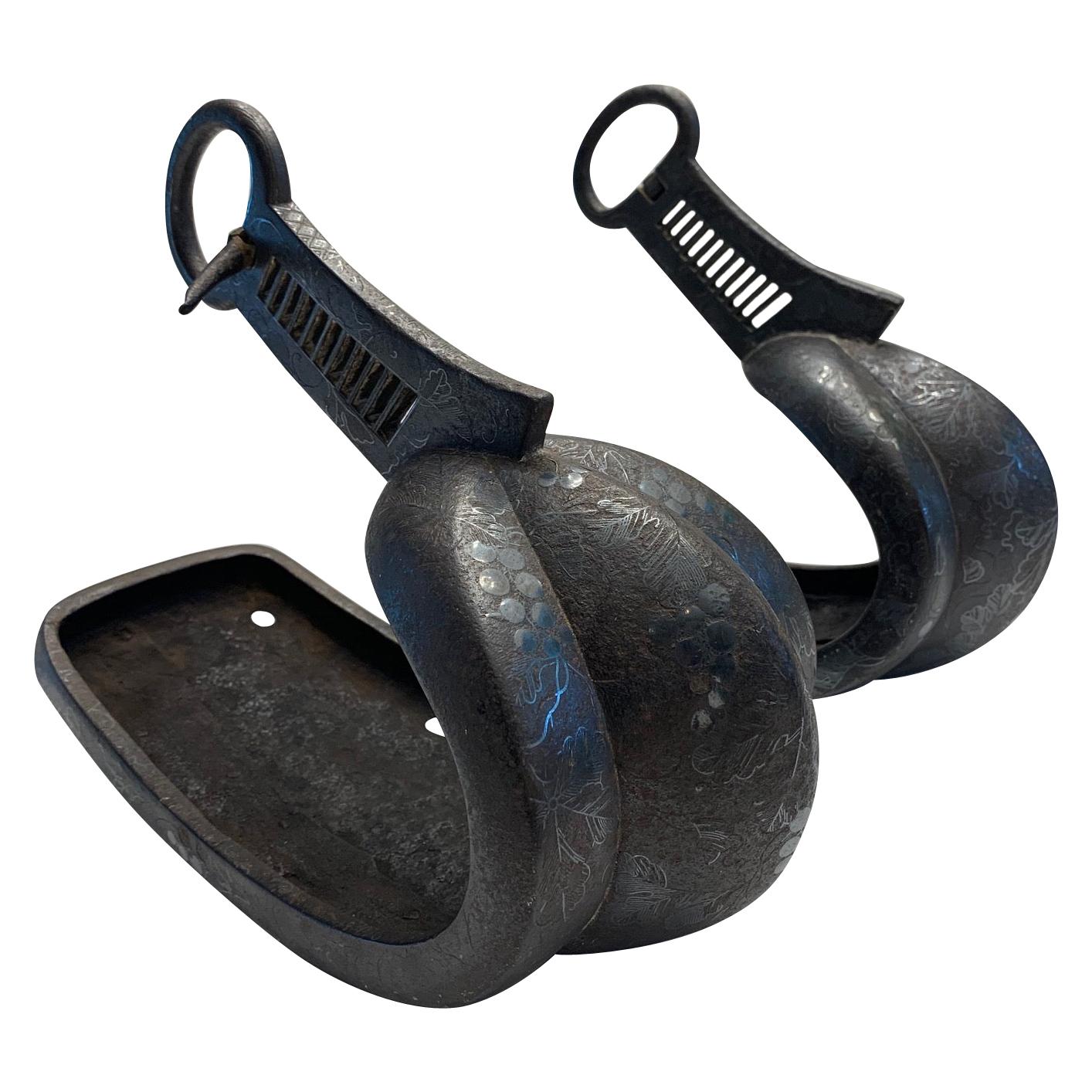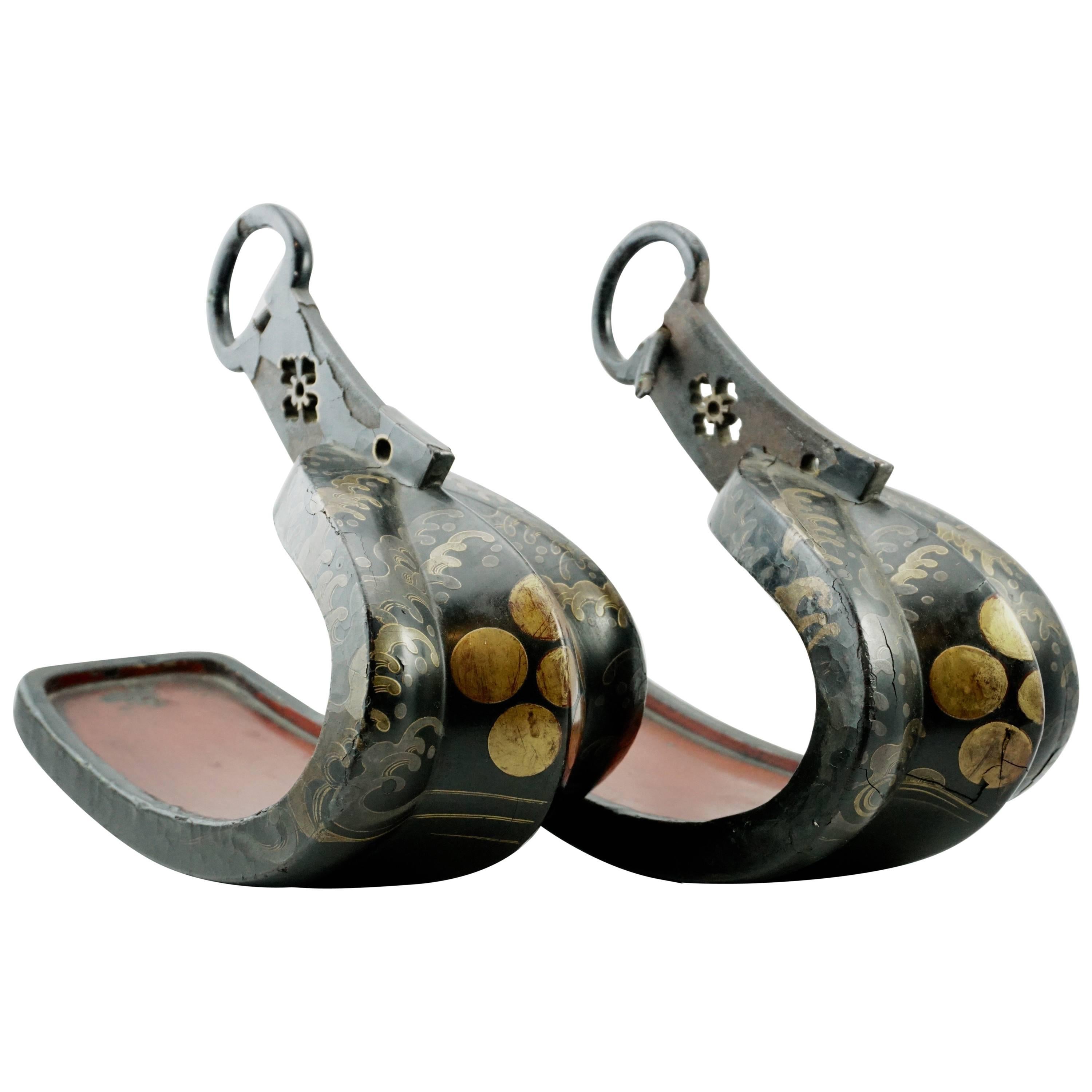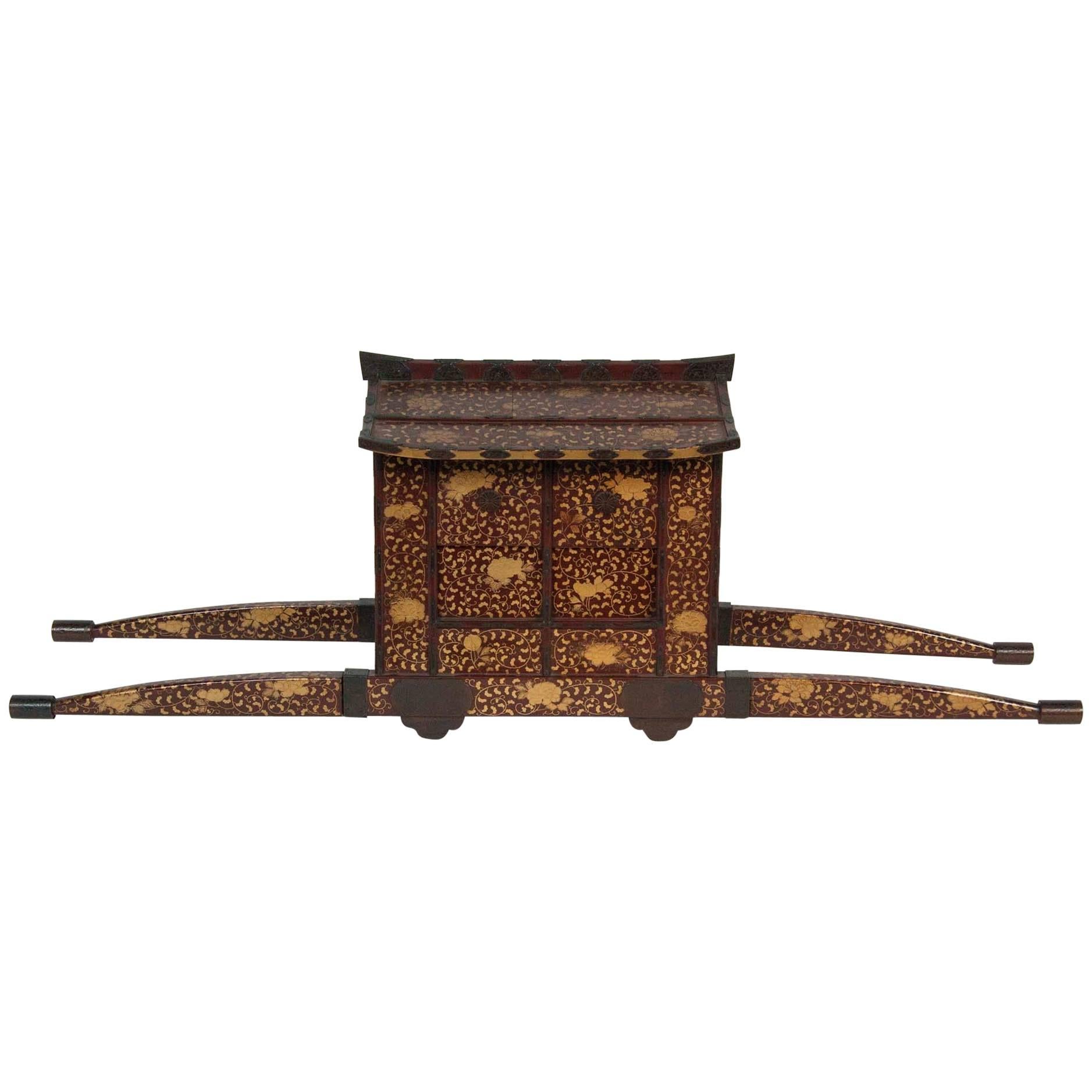Items Similar to Pair of Japanese Edo Period Iron Silver Inlaid Red Lacquered Stirrups 'Abumi'
Want more images or videos?
Request additional images or videos from the seller
1 of 13
Pair of Japanese Edo Period Iron Silver Inlaid Red Lacquered Stirrups 'Abumi'
About the Item
A Pair of Japanese Edo Period (1603–1867) iron, silver inlaid, and red lacquered stirrups (Abumi). Each of typical form, made of iron with silver inlay on the front with floral blossoms borne on leafy vines, with silver inlaid clouds underneath. The interior red-lacquered and of the finest quality. These stirrups would have provided a firm platform for an archer or swordsman on horseback to stand and fight. they are made of iron, patterned with silver flowers. Inside, the stirrups are lined with lacquered wood. Each of these are signed with province and makers name in silver inlay.
Japan, Circa: 1680.
- Dimensions:Height: 10.25 in (26.04 cm)Width: 11.5 in (29.21 cm)Depth: 5.5 in (13.97 cm)
- Sold As:Set of 2
- Style:Edo (Of the Period)
- Materials and Techniques:
- Place of Origin:
- Period:1690-1699
- Date of Manufacture:1690
- Condition:Wear consistent with age and use.
- Seller Location:New York, NY
- Reference Number:1stDibs: LU919528534272
About the Seller
4.9
Platinum Seller
These expertly vetted sellers are 1stDibs' most experienced sellers and are rated highest by our customers.
Established in 1820
1stDibs seller since 2011
137 sales on 1stDibs
Typical response time: 1 hour
- ShippingRetrieving quote...Ships From: New York, NY
- Return PolicyA return for this item may be initiated within 1 day of delivery.
More From This SellerView All
- Japanese Meji Period Mixed Metal Plaque Attb. to Suzuki Chokichi 'Kaka'Located in New York, NYA large, fine quality, and world class Japanese Meiji period mixed metal plaque with Shakudo-inlay, silver-inlay, gold-inlay, copper-inlay, and patina, attributed to the famous Suzuki Chokichi...Category
Antique 19th Century Japanese Meiji Metalwork
MaterialsMetal, Gold, Silver, Copper
- A Japanese Meiji Period Patinated Bronze Centerpiece/Bowl w/ Dragon in ReliefLocated in New York, NYA Fantastic and large Japanese Meiji Period Patinated Bronze Centerpiece/Bowl/jar denier with Dragon in Relief. This captivating and exquisite, hand-crafted, patinated bronze centerpiece serves as a remarkable focal point, adorned with marvelously hand-chassed and hand-chiseled dragons in relief, gracefully emerging and disappearing behind artfully stylized scrolling etched clouds. The centerpiece boasts a substantial and graceful curved base, complemented by a striking peaked and square-edged lip atop the vessel. The significance behind the depiction of the three-clawed dragons stems from the Japanese belief that Eastern dragons originated within their native land. According to their folklore, as these majestic creatures ventured away from Japan, they acquired additional toes. The Japanese Sky dragon...Category
Antique 1890s Japanese Meiji Metalwork
MaterialsBronze
- Meiji Japanese Bronze Jardinière Japanese People on a Boat, Genryusai Seiya ZoLocated in New York, NYA masterpiece, rare, 19th Century Japanese bronze Jardinière/centerpiece of a group of Japanese travelers on a boat, signed on the bottom, Genryusai Seiya...Category
Antique Early 1900s Japanese Meiji Metalwork
MaterialsBronze
- French Patinated Bronze Figure of a Standing Japanese Geisha with Kimono & ObiLocated in New York, NYA beautiful French patinated bronze figure of a standing Japanese geisha in a traditional kimono with an obi. This geisha is exceptionally cast with immense detail. Starting from the...Category
Early 20th Century French Japonisme Figurative Sculptures
MaterialsBronze
- Silver Figures of Eight Immortals Yangqinghe Jiuji Marks, Late Qing DynastyLocated in New York, NYImportant and rare silver figures of eight immortals Yangqinghe Jiuji marks, Late Qing dynasty. Each hollow figure portraying one of the immortals in an animated pose, with highly detailed facial features, four pierced with apertures for the insertion of facial hair, clad in finely chased robes, all but two with their characteristic attributes, their bases bearing either two seal marks reading Yangqinghe Jiuji gongyibu and Zhe'ning Hu Qiusheng zao, or three marks in regular script reading Yangqinghe Jiuji gongyibu, Shang and Sheng zuo, original hand-carved wood stands. Measures: 11 1/4in (28.5cm) high (tallest one). The earliest records of the silver atelier known as Yangqinghe date to 1775 in Shanghai...Category
Antique 1890s Chinese Chinese Export Metalwork
MaterialsSilver
- Massive Pair of 19th C. Chinese Cloisonne Enamel Vases with Deer DecorationLocated in New York, NYA massive and impressive Pair of 19th C. Chinese Cloisonne Enamel Vases with '100' Deer Decoration. Decorated with a multitude of deer and birds amongst a meadow with flowering branc...Category
Antique 1850s Chinese Qing Metalwork
MaterialsBronze, Enamel
You May Also Like
- Pair of Japanese Abumi StirrupsLocated in PARIS, FRPair of stamped brass stirrups decorated with Hashizuka, Ito and Manabe Mons. Japan - Edo (1615-1868), 18th century. Height: 10.24 in. (26 cm), length: 12.6 in. (32 cm), width 4.72 in. (12 cm) As in Western culture, the culture Japanese stirrups were part of traditional accessories...Category
Antique Late 18th Century Japanese Metalwork
MaterialsBrass
- Japanese Cast Bronze "Longevity" Mirror, Edo Period, 18th Century, JapanLocated in Austin, TXA heavy and finely cast Japanese bronze mirror with longevity symbols, Edo Period, 18th century, Japan. The small, round mirror with high walls...Category
Antique Late 18th Century Japanese Edo Metalwork
MaterialsBronze
- Antique Japanese Iron Stirrups with Silver Inlay SignedLocated in Atlanta, GAA pair of antique Japanese Abumis, stirrup for horse-riding, in cast iron with elaborate silver inlay, circa 16th century Muramachi to Momoyama period. The prototype of Japanese abum...Category
Antique 16th Century Japanese Japonisme Metalwork
MaterialsSilver, Iron
- Pair of Japanese Abumi Samurai Stirrups with Dragons, c. 1800Located in Chicago, ILInlaid with brass and silver, this extraordinary pair of Japanese bronze stirrups, known as Abumi, were crafted in the Edo period (1603-1868) for use on a Samurai's horse. Each is wo...Category
Antique Early 19th Century Japanese Edo Metalwork
MaterialsSilver, Bronze, Iron
- Pair of 18th Century Japanese Edo Period Lacquered Samurai Iron StirupsLocated in Dallas, TX18th century Japanese Edo period Lacquered Samouri Iron stirups with original wooden lacquered insoles. Truly a beautiful pair of Japanese ...Category
Antique Late 18th Century Japanese Edo Metalwork
MaterialsIron
- Japanese Edo-Meiji Period Lacquered PalanquinLocated in Stamford, CTA Japanese Edo-Meiji period Palanquin chair for the childrens festival. The form with sliding and hinged doors, decorated in gold hiramaki-e with peonies ...Category
Antique 1890s Japanese Edo More Asian Art, Objects and Furniture
MaterialsLacquer





